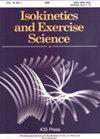Effect of plyometric training on dynamic leg strength and jumping performance in rhythmic gymnastics: A preliminary study
IF 0.7
4区 医学
Q4 ENGINEERING, BIOMEDICAL
引用次数: 3
Abstract
BACKGROUND: Reactive performance is an important component of rhythmic gymnastics. So far, it is unclear whether additional plyometric training in female gymnasts shows an increase in performance. OBJECTIVE: The aim of the study was to examine the effect of additional plyometric training in rhythmic gymnastics on the reactive jumping performance and strength of the lower leg muscles. METHODS: Fifteen rhythmic gymnasts (age: 12.3 ± 2.6 years, height: 1.47 ± 0.12 m, body weight: 37.3 ± 9.3 kg, BMI: 16.7 ± 2.1 kg*m-2; competition level: national and international championships, Tanner stages I–III) participated in the study. The athletes were assigned to an experimental (EG) and a control group (CG). The EG performed plyometric exercises three times per week in addition to the regular training. Before and after six weeks of training the reactive jump performance, the work of dorsi flexors and plantar flexors performed during isokinetic plantarflexion, as well as the performance in two sport-specific tests were measured. RESULTS: In contrast to the CG, in the EG the jump height (pre: 24.8; post: 27.25 cm; p< 0.05) and the reactive-strength-index (pre: 1.01; post: 1.19; p< 0.01) increased significantly. The EG achieved significant improvements in the counter movement jump test (pre: 27.0 cm; post: 31.5 cm; p< 0.01) and in the sport specific double rope jump test (jumps per minute, pre: 18.0; post: 23.0; p< 0.01). Furthermore, a significant increase in work performed during plantarflexion was found in the EG for the right leg (pre: 24.9 J; post: 29.7 J; p< 0.01) and a tendency to increase for the left leg (pre: 26.4 J; post: 37.7 J; p= 0.05). CONCLUSION: Both reactive strength and dynamic force can be efficiently increased by plyometric training. It may be recommended to include plyometric exercises in the training regime of rhythmic gymnasts.增强式训练对艺术体操动态腿部力量和跳跃性能影响的初步研究
背景:反应表演是艺术体操的重要组成部分。到目前为止,还不清楚女性体操运动员进行额外的增强式训练是否能提高成绩。目的:本研究的目的是研究艺术体操中额外的增强训练对反应性跳跃表现和下肢肌肉力量的影响。方法:15名艺术体操运动员(年龄:12.3±2.6岁,身高:1.47±0.12 m,体重:37.3±9.3 kg, BMI: 16.7±2.1 kg*m-2;比赛水平:国家和国际锦标赛,坦纳阶段I-III)参与研究。将运动员分为实验组(EG)和对照组(CG)。EG在常规训练之外,每周进行三次增强运动。在训练前后6周的反应性跳跃表现,背屈肌和足底屈肌在等速屈曲时的工作,以及在两个运动特定测试中的表现进行了测量。结果:与CG相比,EG中跳跃高度(前:24.8;身高:27.25厘米;P < 0.05),反应强度指数(前值:1.01;职位:1.19;P < 0.01)显著升高。EG在反动作跳跃测试中取得了显著的进步(前:27.0 cm;立柱:31.5 cm;P < 0.01),在运动专项双跳绳测试中(跳数/分钟,预:18.0;职位:23.0;p < 0.01)。此外,右腿的EG在跖屈期间进行的工作显著增加(pre: 24.9 J;岗位:29.7 J;p< 0.01),左腿有增加的趋势(前:26.4 J;岗位:37.7 J;p = 0.05)。结论:增强训练能有效提高反应性力量和动力。建议在艺术体操运动员的训练中加入增强式练习。
本文章由计算机程序翻译,如有差异,请以英文原文为准。
求助全文
约1分钟内获得全文
求助全文
来源期刊

Isokinetics and Exercise Science
医学-工程:生物医学
CiteScore
1.20
自引率
14.30%
发文量
37
审稿时长
>12 weeks
期刊介绍:
Isokinetics and Exercise Science (IES) is an international journal devoted to the study of theoretical and applied aspects of human muscle performance. Since isokinetic dynamometry constitutes the major tool in this area, the journal takes a particular interest in exploring the considerable potential of this technology.
IES publishes studies associated with the methodology of muscle performance especially with respect to the issues of reproducibility and validity of testing, description of normal and pathological mechanical parameters which are derivable from muscle testing, applications in basic research topics such as motor learning paradigms and electromyography. The journal also publishes studies on applications in clinical settings and technical aspects of the various measurement systems employed in human muscle performance research.
The journal welcomes submissions in the form of research papers, reviews, case studies and technical reports from professionals in the fields of sports medicine, orthopaedic and neurological rehabilitation and exercise physiology.
 求助内容:
求助内容: 应助结果提醒方式:
应助结果提醒方式:


